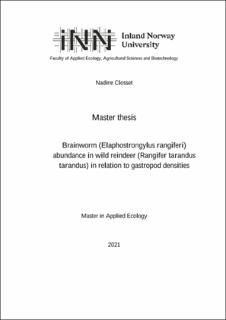Brainworm (Elaphostrongylus rangiferi) abundance in wild reindeer (Rangifer tarandus tarandus) in relation to gastropod densities
Master thesis
Permanent lenke
https://hdl.handle.net/11250/2787059Utgivelsesdato
2021Metadata
Vis full innførselSamlinger
Sammendrag
Elaphostrongylus rangiferi is a nematode parasite in reindeer (Rangifer tarandus) which can cause considerable neurological damage and could affect the survival chances of the last European wild tundra reindeer. The parasite has terrestrial gastropods as intermediate hosts. Previous research has shown that the development of E. rangiferi inside gastropods is highly temperature-dependent, with faster development at higher temperatures. Additionally, the prevalence and abundance of E. rangiferi has previously been reported to be lower in reindeer grazing at high altitudes, but whether this difference in infection rate is connected to gastropod densities is unknown. Here I showed that overall prevalence and abundance of E. rangiferi was significantly higher for reindeer that are in summer pastures with a high predicted gastropod density. These areas were mainly forested areas at low altitudes. The prevalence and abundance of E. rangiferi changed over time, with maximal output in faecal samples during early spring. Overall prevalence and abundance were considered to be relatively low compared to other studies on both wild and semi-domesticated reindeer. Previous studies suggested that the higher prevalence of E. rangiferi in reindeer grazing in low altitudes was mainly connected to higher temperatures. My results provide a new dimension into understanding risk areas for E. rangiferi transmission. My study showed that the parasite was common in the wild reindeer population of Rondane, a population from which there was little prior information. In light of climate change, prevalence and density of this parasite in reindeer is expected to increase. This makes E. rangiferi a parasite of increasing concern. My findings, in combination with previous research, could be used by both reindeer herders and conservation managers for management and mitigation strategies of reindeer to prevent future outbreaks of E. rangiferi.
